Today I’m showing you how to build a wood countertop with undermount sink. The one I built for my laundry room also has a sink insert so I can use the entire length to fold laundry. Wood counters like this would also work great in a bathroom or for a kitchen island. An inexpensive kitchen countertop would be easy to make. My total cost for this puppy was $25
Check out this countertop in the completed laundry room.
DIY wood countertops
What you’ll need:
- Five 8′ 2×6
- Wood glue
- Lots of clamps!
The cost of a 2×6 is about $5 so this probably the cheapest countertop I could make. It’s inexpensive construction lumber so it’s quite soft. With that in mind, I purposefully distressed it before staining and oiling it. The finish will harden the surface a bit but it will still get more dings and dents as it gets used. Distressing it to begin with makes it look more like reclaimed pine, so all the future “wear and tear” will just add to the character.
Distressing Wood
This is the fun part. Use whatever items you see laying around to scratch, scrape and hammer the wood. Distress it until you like how it looks. I like, chains, hammers, chisels, nails, wire brushes, screwdrivers and rocks.
Join the planks together using clamps and wood glue. Below I’ll give you a quick explanation of how to join planks. If you want more details, check out my X leg bench tutorial.
How to build a wood countertop
- Trim the edges of each 2×6 with a jointer or on a table saw.
- Glue and clamp them together to form one wide wood plank
- If you are worried about keeping the whole surface flat during clamping, join pairs of 2×6 at a time. After the glue has dried, join the pairs together. That way you’re only worried about keeping one joint flat and even –at any given time.
Scrape off any excess glue once it’s set up. Then sand the entire top with a belt sander. Belt sanders take off a lot of wood FAST. Make sure you keep it moving all the time. Try to make sure you sand the whole surface evenly.
Lay a straight edge across the whole surface to make sure the countertop is even. If you see daylight under the straight edge, you’ll know where the high points are. Sand those areas more and then check again.
Then smooth the surface with a random orbital sander. Start with 80 grit followed by 120 then 220. I like to make sure to round the front edge because I don’t like sharp corners.
I got so excited about how pretty the wood countertop was looking that I started staining. Forgetting all about my plan to cut out a sink insert.
Staining
I almost always use more than one color for staining wood. Sometimes I stain with Briwax. This time I’m using black and dark brown stain. Smear it on, wipe it off and let it dry. Then do it all again.
Wood countertop with undermount sink
When I remembered that I needed a hole for my sink I temporarily discontinued my finishing efforts. I’ll have to sand and finish the edges once I cut the hole.
Cutting out a hole for the sink
Luckily my sink came with a template that made this task super easy. After placing my template in the correct place, I used a Sharpee to trace the shape.
Normally when using a jigsaw, I drill a starter hole so I can get the jigsaw blade in the wood in order to cut. I’m planning on using the cut out so I didn’t want to drill a hole — so I used a small circular saw to start the cut. The Matrix came in handy for that.
After cutting out the sink hole, I had to sand again… and then stain again. I simply apply layers of stain until I like what I see.
After three or four coats of stain I applied three coats of Waterlox tung oil. It penetrates the wood so the wood absorbs less oil with each coat. The wood looks quite dull after the first coat. With each consecutive coat the wood looks more and more rich.
I installed the undermount sink with the hardware provided with the sink. That was surprisingly easy.
I purposefully created a slightly larger reveal than you normally see with an undermount sink. With a sink insert I can use the sink area for folding laundry. Then when I need to use the sink, I simply remove the insert. It fits nicely in the cabinet under the sink. Having that extra space to hold laundry baskets or fold and sort makes a big difference. That sink area is about 1/4″ of whole countertop space.
Check that out how I prepared the sink insert.
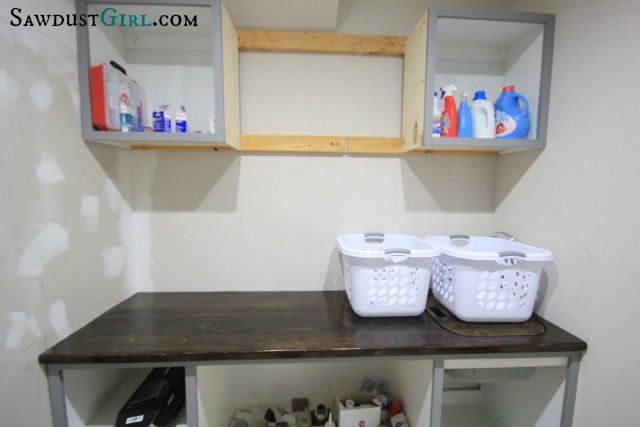

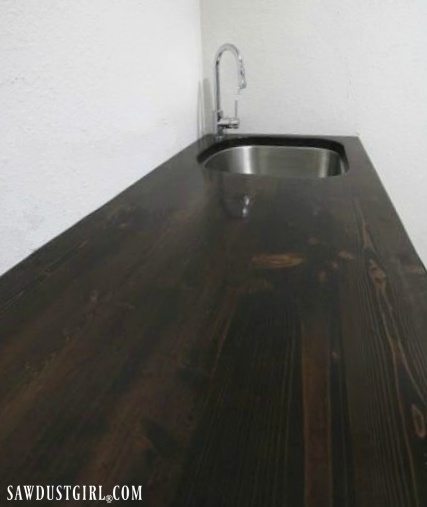
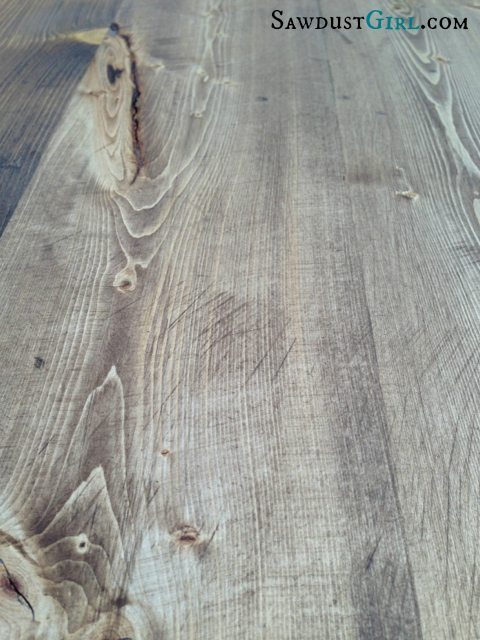
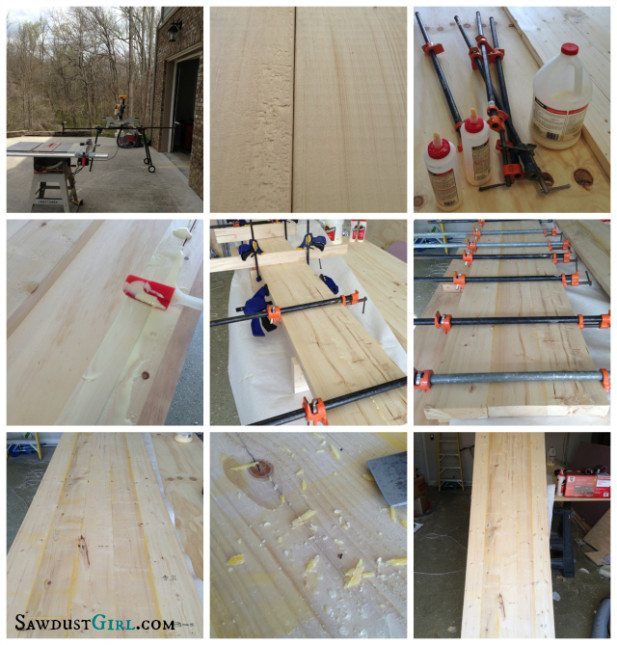
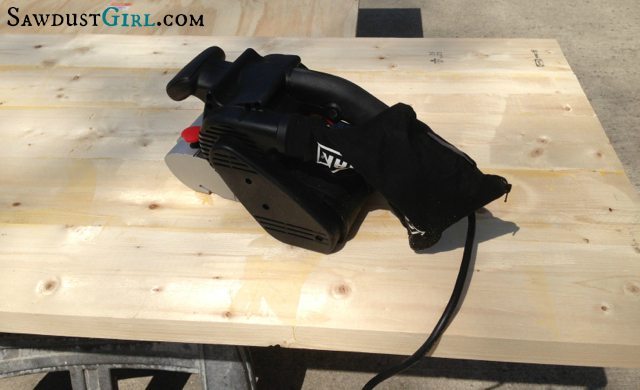
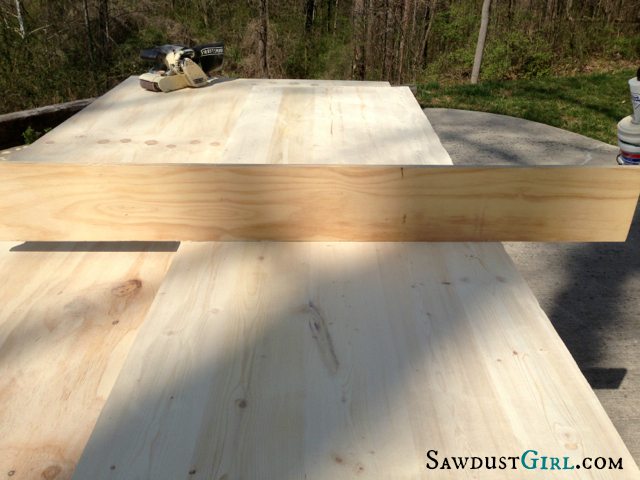
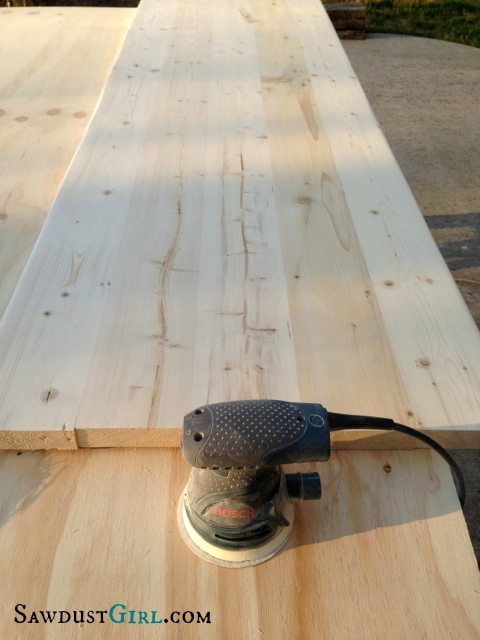
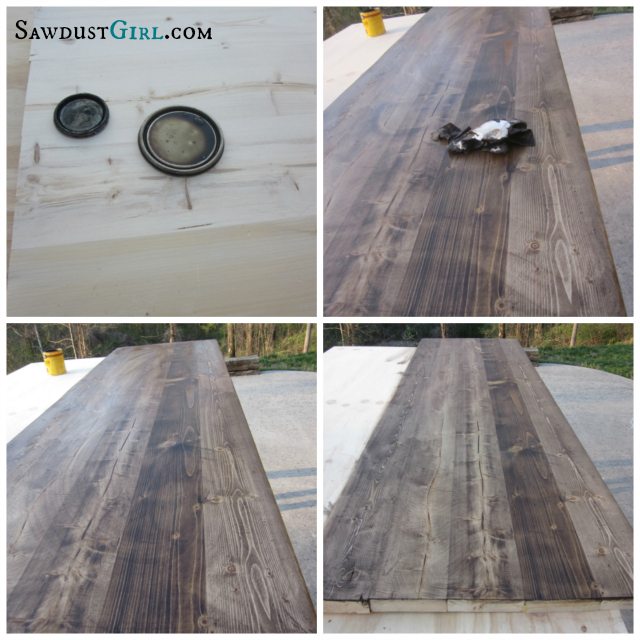
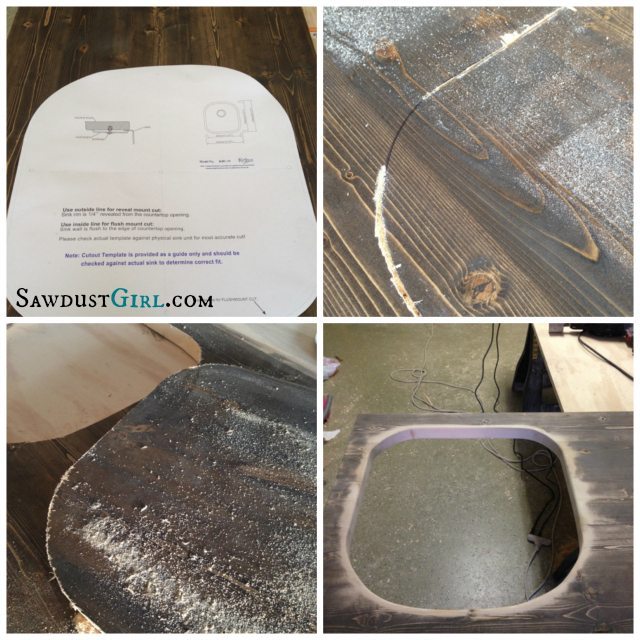
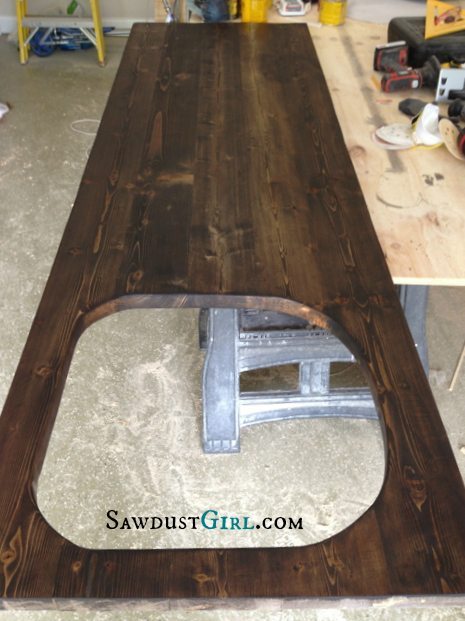
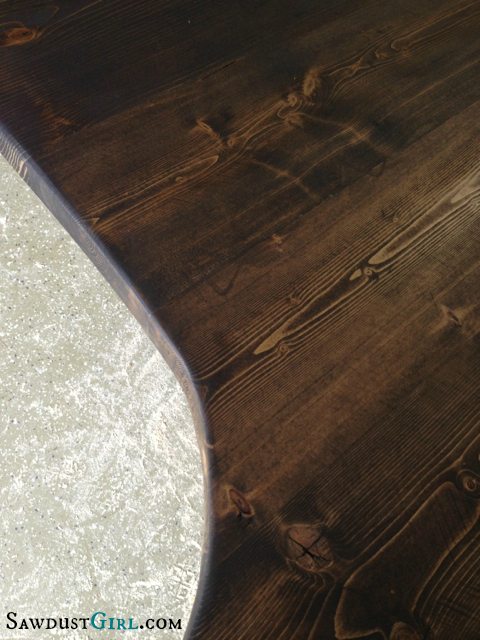
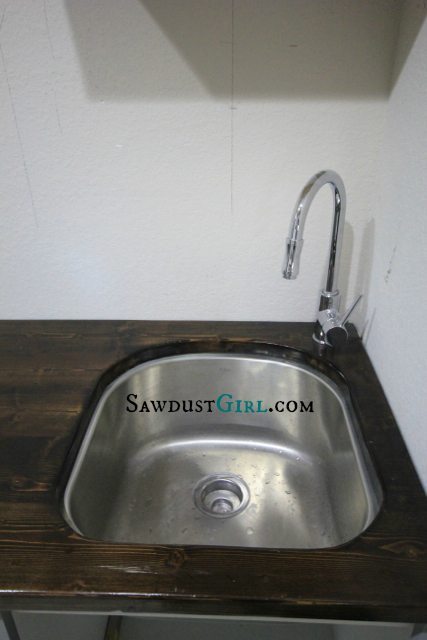
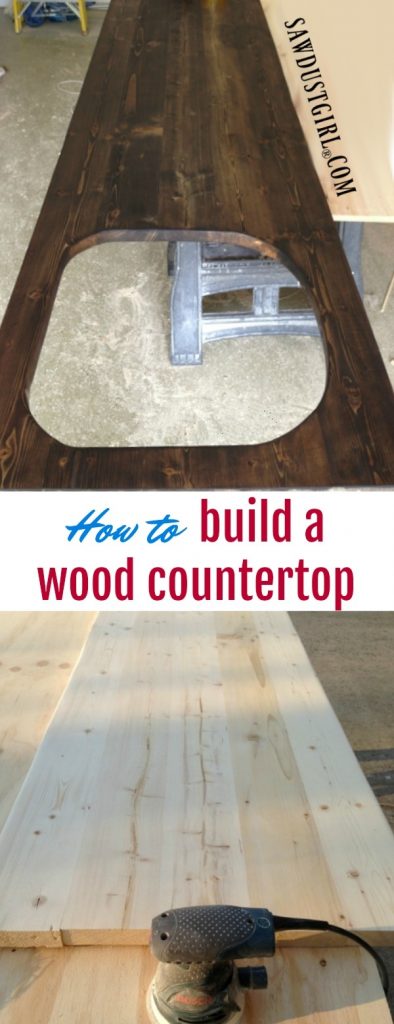
Dawayna says
Do you have a pic of what you set the counter top on? Did you build cabinets or a frame?
Sandra says
There is a photo in the post showing the cabinets the countertop is sitting on.
Shirley Almand says
Would this be the same process for a kitchen counter top?
Sandra says
Yeah, you would just want to make sure you use a food safe coating.
BeckyH says
I’ve been researching wood countertops and it’s posts like yours that encourage me. I was going to buy a pocket hole jig — a cheap and simple one — but with your comments about pocket holes, I’ve decided not to. You make the whole process so simple. I’m looking forward to my new countertops! Thanks!
Sandra says
Pocket holes are useful for building certain things but not necessary when glueing flat pieces of wood together, end to end.
Linda says
Can I buy a plank countertop from you? I would have to get all the machinery for sanding wouldnt that be a bit much if I am needing one counter top?
Sandra says
You can buy a wood countertop pretty inexpensively. Not as inexpensively as making it yourself but cheaper than buying all the tools or hiring me to make one (which I don’t currently have time to do). Southern Salvage has quite a lot of different wood countertops too choose from and they’re pretty cheap. Check them out.
Mechilli Alsup says
Is the thing oil food safe?
Lindi says
What kind of clamps do you use and their sizes please
Aimee says
The glue is the only thing holding the boards together? Any concern on weight issues?
Sandra says
Wood glue binds the two surfaces. It is generally stronger than the wood itself. Nothing more than glue is needed to “laminate” multiple pieces of wood together. You see a lot of makers using pocket screws. This could help pull the pieces together while the glue sets if you don’t have clamps. However, keeping the piece flat becomes a concern. Because pocket hole screws drive in at an angle, they tend to want to pull a buckle into the seem. You have to make sure the surface of the slab remains flat during the glue up, whether you use screws or clamps.
Kate says
Looks amazing! Have you had any problems with the expansion and contraction of the wood?
Sandra says
No problems. Wood will always move. The key is to allow it to happen.
Paula says
Do you have issues with the end grain of the wood around the sink? I am looking into to making counter tops for my kitchen and have concerns.
Sandra says
I have not had any issues. The sink cutout is sanded smooth and sealed.
Paula Dunlap says
Thank you so much. Will definitely be making my own counter tops.
Brittany says
Did you polyurethane it after staining it?
Sandra says
No. I used Tung Oil to seal it.
CatiE says
Hey! Hope you get this!! I love your work! Wondering about the Waterlox sealer..do you have to sand between coats? That’s what I hate about poly/paint. Thanks!
Sandra says
no you don’t. That’s why I love it
Molly schmidt says
Hi! I know this post was from a while ago but I’m looking to make wood countertops for my kitchen and am in Love with these. I was wondering what kind of wood this is and what stain you used? Thanks
Dana Cramer says
was wondering how this would work in a farmhouse Kitchen with a farmhouse sink I love the distressed look .. could I coat with polyurethane instead of the Tung oil for a thicker shine?
Clara.B says
I am wanting to do wood countertops for our kitchen and possibly bathrooms… I use trivets and cutting boards, so I’m not real nervous about damaging them that way. I’m more curious about your thoughts on what type of wood/sealer to use. I have seen some folks use cheap lumber and then others say you MUST use hardwood.
AYISHA says
How long does Tung oil take to technically “dry”? Does it smell terrible while doing so.
Sandra says
It is very smelly. You should really wear a respirator while applying it and proper gloves. 24 hours between coats.
Ayisha says
How long do you let it cure after the final coat? I’m really considering trying this in my laundry room. But the thought of leaving it in my garage for a month just to avoid the curing smell is discouraging.
Tori says
I’m totally guessing, but are you reusing the cutout in the sink? That would be a reason for the edge inside the sink……to hold the cutout in place! Maybe for extra folding space when not using the sink?! If not, it gave me a great idea for when we redo our laundry sink!!!
Sandra says
that is exactly what I did with it. Sharing that tomorrow. 🙂
Chantelle - ThousandSquareFeet says
Totally, totally, totally going to do this for our school room counters. I was wondering what kind of counter to make and this . . . THIS is perfect!
Janis says
This awesome post just helped me to decide how to do the top on some built-in bookcases (only 4.5′ tall but 12′ wide along the wall with a window above) I’m working on. I’m curious to know how you dispose of your rags. I’m having a hard time impressing upon my husband the danger of improper disposal 🙁
Sandra says
Rags are submerged in water in an old paint can and sealed. When full — disposed of at the hazardous waste drop off. I’ve never seen spontaneous combustion but that is the concern and I certainly don’t want to burn down my shop (and house) because I’ve thrown rags into a trash bag full of sawdust.
Janis says
Excellent. That is easy. Thanks for letting me know.
Linda says
I have had rags combust. It is bad. I had spread them out thinking that a rag that wasn’t bunched up would combust, wrong! I woke up to the backyard trash cans on fire with the side of the house getting charred and soon to catch.
MarieRoxanne says
Shiny countertop. Love the dark stain.